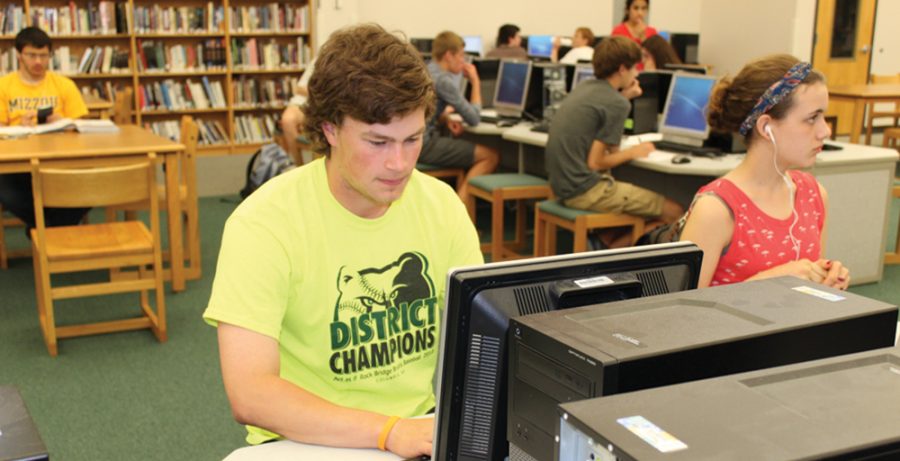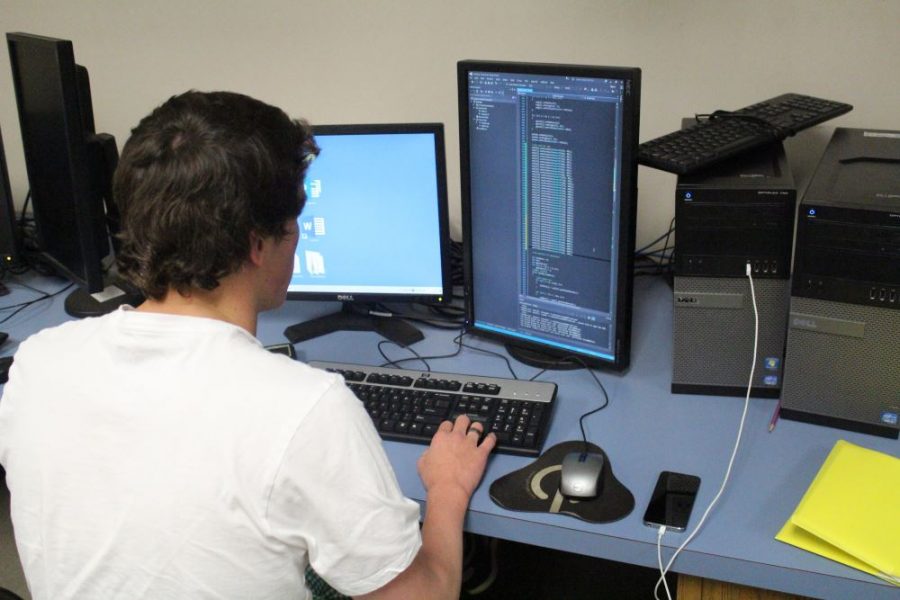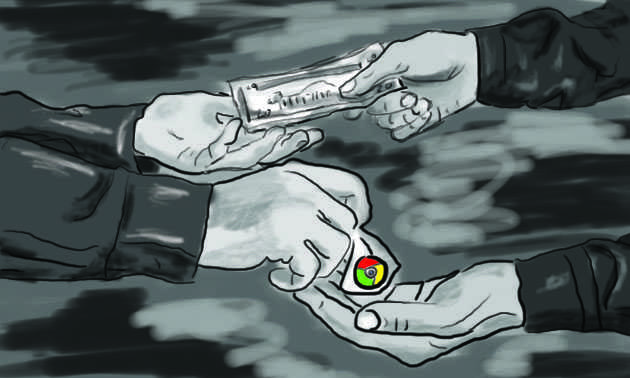[heading size=”15″ margin=”15″]Students explore the new role technology plays in the classroom[/heading] During the school day, the RBHS media center is a near constant jumble of students working on assignments and socializing with friends. On one of the off hours, the only noise one can hear is the muffled murmur of voices discussing school, weekend plans and many other things. Students can be found working at both tables and computers, studying and scribbling away.
Altogether, there are 57 computers in the library, not including laptops. The media center looks different compared to a high school library from merely a few decades ago. Now, the majority of students do a large amount of their school work on the computer, and some of those assignments fall into the homework category.
Freshman Katherine Dudley sits at one of the computers, intently focused on the screen. Dudley is working on MathXL for School, a form of online homework. Dudley believes the online math homework is a great learning tool and does not have many gripes about it.
“I like that you can check your work to make sure you got the right answer, so you know you always get it 100 percent right and I like how you can look up examples,” Dudley said. “It’s really easy to learn from your mistakes, although some of the questions are a little confusing; like you’ll type in the correct answer but then they’ll say it’s wrong because it’s not in the correct format.”
Dudley says if given a choice, she would want to do online math homework instead of sheet homework.
According to a study from the University of California, Dudley is not alone. The study showed that 64 percent of undergraduates and 70 percent of graduate students felt online homework was more beneficial than traditional homework.
“It’s good to have a balance … between being able to show your work,” Dudley said. “It [online homework] is nice sometimes because it goes a little faster when you just type in the answer and be done.”
As technology becomes more integrated into student’s daily lives, it is inevitable that they would eventually be doing mundane things, like their homework, on the web. With online sites like Quizlet, studying is made easier, allowing students to share flashcards and notes on thousands of different topics.
Quizlet is a giant resource for anyone trying to find an extra studying outlet. In 2014, Quizlet had 20 million registered users and 60 million user-generated flash cards.
Senior CJ Phillips uses Quizlet as a supplement to his classes. One class that may as well have required the use of Quizlet, was Latin.
Often, Phillips’ teacher would post on the site and use the posts similar to a study guide for quizzes and tests.
“We had regular tests over terms and so it was just a really convenient way [to study],” Phillips said. “It’s community based, so you can always find a source that is credible.”
As for any problems with Quizlet, Phillips is satisfied with the overall quality of the program.
“I think there’s a lot of options there so there’s always something to do,” Phillips said.
Online math homework also offers extra practice outside of class for students to take advantage of.
The way most math online homework operates is by asking an open-ended question and requiring the student to answer the question. The sites prevent cheating by changing the problem’s numbers after a student has missed it three times.
Geometry and Algebra 2 teacher Peter Willett started using online homework with his classes last year, when the district decided not to buy textbooks for every student. He says one of the main reasons he likes the online homework is because it saves students from spending time doing the wrong work.
“Online homework gives the opportunity for instant feedback,” Willett said. “It’s always been a heartbreaking thing as a teacher to have a student do a bunch of work and not realize that they’ve been doing something wrong the whole time, and have spent all this time not really learning how to do it correctly, so the online homework has that huge benefit.”
The drawbacks to online homework are prominent, some of which students cannot help. Around half of all low-income families do not have internet access, which is something students need to complete online homework.
“There have been some students, not most, but some students don’t have internet access at home for whatever reason,” Willett said, “and so they are at a disadvantage, when they’re at home, to be able to do their homework.”
Willet thinks students sometimes manipulate the system and use the “help me solve this” option too much. When students use this button, they are given an example that is very similar to the problem they are solving, usually exactly the same, but with different numbers.
“In math sometimes we have online examples [on the online homework] and some people have been over-depending on those examples,” Willett said, “and so they’re always having a worked out example right next to the problem, and they are not practicing it on their own, independently.”
Willett also has some qualms about the resources RBHS presents to students to work on their homework.
“It [online homework] is really tedious on an iPad. It was a district decision to get us iPads. We much would have preferred laptops. It’s a lot easier to do homework on,” Willett said, “So the technology we have available in our classrooms is not the ideal technology. It’s certainly better than nothing, but it’s not ideal.”
Other resources, like Google Classroom, are making school more accessible online. Daniel Rouder uses Classroom to turn in his essays for AP world.
All students have access to Google Classroom through their student google accounts.
Rouder writes his essays on Google Docs and then turns in his assignments on Google Drive. Students can also check the upcoming assignments on their Google Classroom accounts.
“It makes deadlines more available to us, like they’ll set deadlines for Sunday nights,” Rouder said. “We usually do them [all our assignments] online; it’s just easier and more organized that way.”
Nick Parmely, a college student at the University of Missouri College of Education, found out about Google Classroom through a workshop done by Columbia Public Schools.
Parmely decided to use Google Classroom during his time as a student teacher to collect information from students, and also to reinforce ideas from class by posting wrap-up videos of the lesson learned in class.
“I like that students can [since we are partnered with Columbia] access it on their phones, through an app or a tablet, or online,” Parmely said. “It’s kind of a learning curve to figure out how to work stuff. [For example] … we did a survey, and not everyone could have access to do the survey, and I have no idea why. That’s something I would need to look into.”
The more willing a teacher is to incorporate technology into the classroom, the more likely a student is to adapt to the change. Parmely says he will use the program with his future students, if it is available at the school he is teaching at.
“I’ll definitely use something like [Google Docs]. It really helps that Columbia is partnered with Google, so all the students already have Google accounts through their emails, which is one big reason why I used it [this year].”
In the end, Parmely is just trying to keep up with the changing ways of teenagers.
“Everybody’s online nowadays,” Parmely said. “I think the ability to have all this information at our hands [is great] … most people can find out everything you ever need to know on your phone, and I think you should definitely use that.”
By Lauren Hofmannphoto by Cassi Viox


















































































